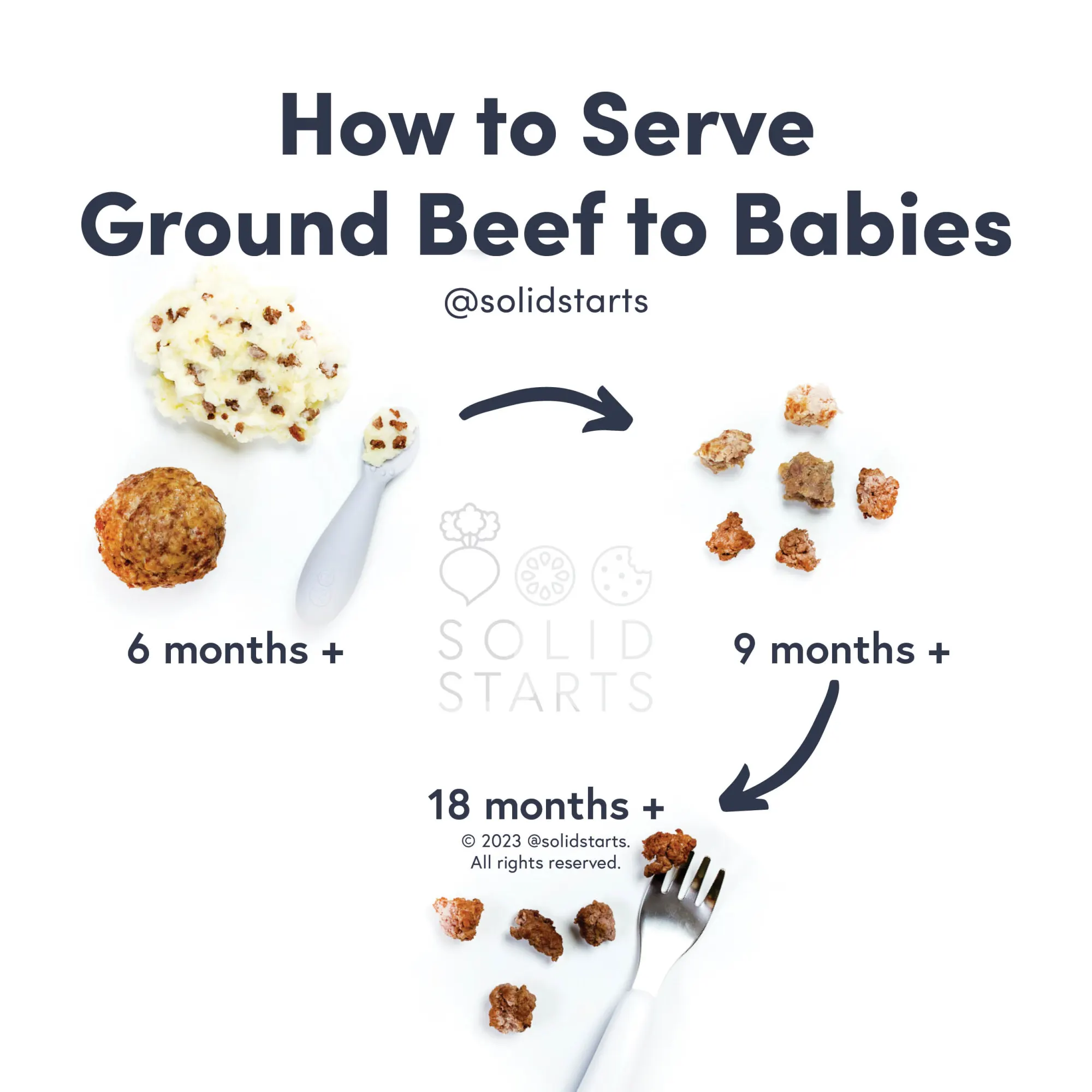Ground Beef
Meat
Age Suggestion
6 months
Iron-Rich
Yes
Common Allergen
No

Warning
Ground beef carries an increased risk for foodborne illness from harmful bacteria like E. coli and Salmonella when the meat is not cooked thoroughly. To minimize the risk, cook ground beef until the internal temperature has reached 160 F (71 C).
When can babies have ground beef?
Ground beef may be introduced as soon as baby is ready to start solids, which is generally around 6 months of age. For information on different cuts and preparations of beef, see brisket and steak.
Is ground beef safe for babies?
Yes, when prepared properly, unless you live in Argentina or another region where there are relatively high rates of hemolytic uremic syndrome, or HUS.
Health organizations in Argentina have stated that ground beef should not be served to children under 5 years of age due to an increased risk of contamination with a particular strain of E.coli (Shiga toxin-producing E. Coli O157) that can cause severe complications, including HUS. HUS is a potentially life-threatening condition that damages the kidneys and affects red blood and clotting cells, and children under 5 years of age and immunocompromised children are among those most at risk. That said, research in Argentina has shown that there are other risk factors for HUS in children, including contact with farm animals and interaction with another child under 5 years of age with diarrhea.
Remember that the recommendation to avoid ground beef is highly region-specific. In the United States, for example, there are no recommendations to avoid cooked ground beef for babies.
Is ground beef healthy for babies?
Yes. Cooked ground beef is a protein-rich food that is often high in fats to fuel baby’s rapid growth. It is also filled with other essential nutrients, such as iron, zinc, selenium, choline, and vitamin B6. Together, these nutrients ensure a healthy metabolism, support growth and development, build a strong immune system, and work to prevent anemia. Around 6 months of age, babies need increasing amounts of iron, and beef offers a great source of dietary iron at this stage of baby’s life.
Always cook ground beef until the internal temperature has reached 160 F (71 C), as ground beef carries a high risk for foodborne illness from harmful bacteria like E. coli and Salmonella when the meat is not cooked thoroughly.
Is ground beef a common allergen?
No. Beef is not a common food allergen, but allergic reactions to beef have been reported. Certain tick bites (mainly the Lone Star tick in North America, but other ticks in different parts of the world), are associated with the development of an allergy to galactose-alpha-1, 3-galactose (“alpha gal”), a sugar which is present in all non-primate mammalian meat. This results in a delayed allergic reaction 3-8 hours after red meat, such as beef, is consumed. However, some individuals with alpha gal allergy also react to small amounts of the sugar present in dairy products, gelatin, or organ tissues (such as liver) from mammals. Alpha gal allergy is more prevalent in the southeastern United States, but is starting to become more common in other areas as the geographic distribution of the Lone Star tick expands. While uncommon, individuals with a dairy allergy may also have a slightly increased risk of being sensitive to beef. Note that studies suggest that in individuals with confirmed allergy to beef, a large percentage are also allergic to cow’s milk.
As you would when introducing any new food, start by offering a small quantity for the first few servings and watch closely as baby eats. If there is no adverse reaction, gradually increase the serving size over time.
Is ground beef a choking hazard for babies?
Yes. Meat is a common choking hazard, though ground beef is less of a risk than, say, a cube or chunk of steak, which doesn’t fall apart as easily. As always, make sure you create a safe eating environment and stay within an arm’s reach of baby during meals. For more information on choking, visit our section on gagging and choking and familiarize yourself with the list of common choking hazards.
Videos
When can babies have meatballs?
Meatballs may be offered to babies starting at 6 months of age, as long as the meatballs are thoroughly cooked, soft, and at least 2 inches (5 cm) in diameter. (The bigger the meatball, the less likely baby will be to shove the whole thing in their mouth.) Smaller, harder meatballs pose a higher risk of choking because they are round, challenging to chew, and closer in size to a baby’s airway. Unfortunately, this includes many brands of store-bought meatballs, so homecooked meatballs can be a safer way to go. If you offer a large meatball and baby munches it down to a concerning size, simply take it away and replace it with a new, large meatball. You can repurpose the half-eaten meatball by mashing into other foods.
When making or purchasing meatballs to share with baby, read the food labels. Meatballs often have sodium levels in excess of what babies need and may contain common allergens, including dairy, egg, sesame, and wheat.
Can babies eat Beyond Meat burgers and other plant-based meat?
Yes—as long as ingredients listed on the food label have been safely introduced. Ingredients used to make plant-based meat vary, but they can lots of protein and plenty of plant-based iron. That said, plant-based meat is highly processed and often contains sodium in excess of what a baby or toddler needs. A bite or two certainly won’t hurt, though if your goal is to minimize sodium, you may want to wait until after the first birthday to serve plant-based meat regularly.
What is the difference between hamburger and ground beef?
Butchering beef carcasses into steaks, roasts, and other popular cuts results in smaller pieces called trimmings that are ground or finely chopped to create ground beef. Hamburger contains ground beef with added beef fat for flavor. How much beef fat is used depends on where you live, as regulations vary by country. In the United States, both ground beef and hamburger may contain no more than 30% of beef fat—and ground beef contains no added fat. The fat in ground beef comes from the trimmings, which can be either lean or fatty. This is why packages of ground beef are often labeled with a ratio, such as 80% lean / 20% fat meat.
How do you serve ground beef to babies?
Every baby develops on their own timeline, and the suggestions on how to cut or prepare particular foods are generalizations for a broad audience.
6 months old +:
Mix ground beef that has been cooked well-done into an easy-to-scoop food like mashed potatoes, polenta, or mashed root vegetables. Let baby get messy by scooping with their hands or offer a pre-loaded spoon to practice with utensils. Avoid serving crumbles of ground beef on their own, as they can pose a higher risk of choking. Alternatively, prepare burgers, meatballs, or patties that are at least 2 inches (5 cm) in diameter and cooked until the internal temperature reaches 160 F (71 C). Make sure the cooked burger or meatball is soft enough to be easily smushed by baby’s gums. To test if it is soft enough, hold it between your thumb and pointer finger and give it a gentle squeeze. Dipping the patties in applesauce, guacamole, yogurt, or other sauces can aid swallowing.
Note: Soft burgers and meatballs often fall apart in the mouth, and when this happens, try to stay calm and give baby the opportunity to work the food forward with the tongue. If your baby needs assistance getting the piece of food out of the mouth, gently tilt them forward and put your hand beneath their chin to indicate they can spit it out. Sticking your own tongue out can help teach babies how to spit.
9 months old +:
Break meatballs or burger patties into small, bite-sized pieces to offer an opportunity for babies and toddlers to practice their pincer grasp and fine motor skills. If baby is not quite ready to pick up smaller pieces of food, you can continue to offer ground beef in sauces or as whole burgers, kebobs, meatballs, or patties that are at least 2 inches (5 cm) in diameter and cooked until the internal temperature has reached 160 F (71 C). Dipping the meat in applesauce, guacamole, yogurt, or other sauces can aid swallowing. If a too-big piece of meat breaks off in the mouth, coach the child to spit the food out by dramatically sticking out your own tongue and saying “ah” repeatedly.
18 months old +:
This age can be a good time to serve a whole hamburger (as a sandwich with a bun and other toppings, rather than deconstructed with the bun and patty consumed separately). Continue to cook the meat until it has reached an internal temperature of 160 F (71 C). Just hold off on ketchup, as it tends to be high in sodium and sugar, and explore other sauces like aioli, chimichurri, or hummus.


Get out of your dinner rut with ideas from our guide, 100 Dinners for Babies & Toddlers.
Written by
Expert Tips Delivered to Your Inbox
Sign up for weekly tips, recipes and more!
The content offered on SolidStarts.com is for informational purposes only. Solidstarts is not engaged in rendering professional advice, whether medical or otherwise, to individual users or their children or families. No content on this site, regardless of date, should ever be used as a substitute for direct medical advice from your doctor or your medical or health professional, nutritionist, or expert in pediatric feeding and eating. By accessing the content on SolidStarts.com, you acknowledge and agree that you are accepting the responsibility for your child’s health and well-being. In return for providing you with an array of content “baby-led weaning” information, you waive any claims that you or your child may have as a result of utilizing the content on SolidStarts.com.








